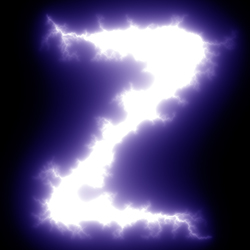|
Tweaking the Rendering
Depending on the size of your input image, the lightning simulation can take a long time to complete. By comparison, the time necessary to render the final glow is relatively quick. Thus, it would be nice if you could try out different render settings without having to re-run the whole simulation. LumosQuad provides the ability to do this. Remember that the example simulation run produced two files, spine.exr and spine.lightning. If we send this *.lightning file to LumosQuad in place of the *.ppm file:
- LumosQuad spine.lightning spine2.exr
then LumosQuad will create spine2.exr relatively quickly, because it will re-use the simulation results from the previous run. This will just regenerate the exact same render as before though, which is not very interesting.
We can change the render settings by specifying an optional third setting. This third setting is a 'scale' parameter, and smaller values will produce larger, blurrier glows, while larger values will produce tighter, sharper glows. The following images demonstrate the effect of this scale parameter.

LumosQuad spine.lightning spine2.exr 1

LumosQuad spine.lightning spine2.exr 2

LumosQuad spine.lightning spine2.exr 4

LumosQuad spine.lightning spine2.exr 8
The larger the scaling parameter, the larger the image resolution will be, and the longer the image will take to render. If you try to render an image that is too large, EXRManip (or rather, FFTW) may return an error that you ran out of memory.
> Tweaking the Simulation
< Go back to Photoshop use
< Go back to EXRManip use
|